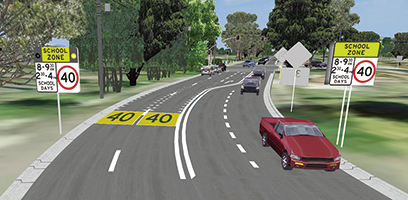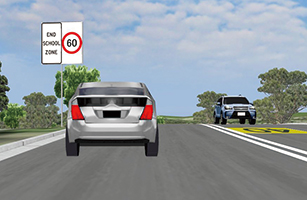Academy User vol.10
Australia
Macquarie University
Uses Forum8 Driving Simulator for advanced driver behaviour research
URL: http://www.mq.edu.au/
Location: Balaclava Road, North Ryde NSW, 2109, Australia
Research Field: Traffic psychology, multitask, sustainable urban traffic
Profile of Macquarie University
Macquarie University was established 50 years ago as the third of Sydney’s
universities. Situated in a 126-hectare park-like setting in Sydney’s northern
suburbs, it currently has around 40,000 students, one-fifth of whom are
international students.
Macquarie has a strong history of teaching and research in the social sciences,
with a large cohort of research students currently studying for a Masters
or PhD under the Faculty of Human Sciences.
Research at Macquarie University focuses on one of five interdisciplinary strategic priorities – Healthy People, Resilient Societies, Prosperous Economies, Secure Planet and Innovative Technologies - that respond to globally significant challenges and opportunities to improve the lives of millions.
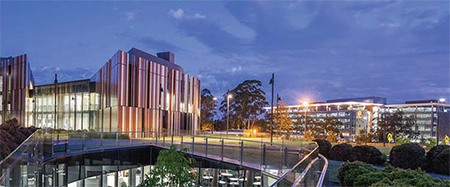 |
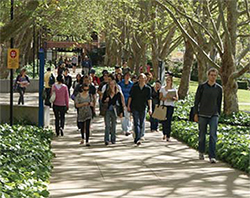 |
 Macquarie University buildings Macquarie University buildings |
 Students on Wally's Walk, central walkway Students on Wally's Walk, central walkway |
Simulation Hub
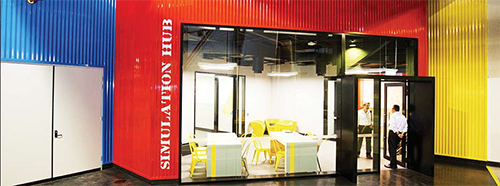
 Simulation Hub entrance
Simulation Hub entranceMacquarie is proud of its multi-billion dollar investment in facilities and infrastructure, including a new Simulation Hub completed in 2014 for the purpose of driving innovation in human performance research.
The first and only facility of its type in the world, the Macquarie University Simulation Hub houses simulation labs for driving, home, work and recreation, flight, motion capture and virtual reality in one location, enabling leading experts from the University and the industry to collaborate on translational research across a wide-range of disciplines.
Both research and commercial training can be conducted using the latest
technology in a safe and controlled environment that mimics the real-world.
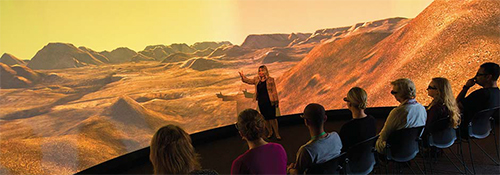
 VR (Virtual Reality) Lab
VR (Virtual Reality) LabDriving simulation laboratory
The driving lab is home to three driving simulators that are used for research into driver behaviour, performance and attention. The driving simulators can be used for driving education purposes by the University and private businesses.
The newest of the three driving simulators was installed by Forum8 in early 2015 and is being used for a number of studies in driver behaviour research. The simulator was supplied with Forum8’s advanced graphical software to replicate the environment and the scenarios for the real-world-based studies that Macquarie conducts.
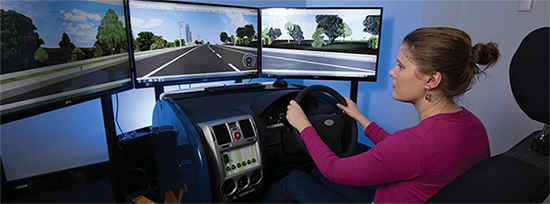
 Driving simulator supplied by Forum8 is used for driver research
Driving simulator supplied by Forum8 is used for driver researchResearch into Lapses in Prospective Memory
|
Dr Julia Irwin is a Senior Lecturer and Director of Undergraduate Studies
in the Department of Psychology, Faculty of Human Sciences, and research
director of the driving simulation laboratory. She currently oversees the
work of several graduate and honours students. Dr Irwin’s research has in particular examined the field of ‘lapses in prospective memory’ which has practical application in the design of safer road systems. |
 |
 Dr Julia Irwin, a Senior Lecturer Dr Julia Irwin, a Senior Lecturer and Director of Undergraduate Studies in the Department of Psychology, Faculty of Human Sciences and research director of the driving simulation laboratory |
But prospective memory is not foolproof. Errors can occur where individuals forget to perform an intended task. Typically this happens when the “normal” flow or sequence of behaviour is interrupted.
In 2014 Dr Irwin and her students conducted research into the “Differential effects of traffic sign stimuli upon speeding in school zones following a traffic light interruption” (http://www.sciencedirect.com/science/article/pii/S0001457515301020?np=y). In Sydney, school zones operate in the vicinity of all schools during the periods of 8-9:30am and 2:30 – 4pm. During those times all vehicles must travel at 40kph or below in the marked zones, forcing drivers to reduce their speed by between 20 km/h and 40 km/h depending on the original speed of the road (60 or 80 kph).
Speeding in school zones
|
The research initially selected four intersections with traffic lights in school zones and using speed gun measurements, was able to prove that a driving task interruption such as stopping at a traffic light often caused the driver to forget that they were in a school zone and take off at a faster speed. Motorists who had stopped at a red traffic signal sped on average, 8.27 km/h over the speed limit compared with only 1.76 km/h over the limit for those who had not been required to stop. Then an intervention (a person holding a flashing “check speed’ sign) was used to remind drivers that they were in a school zone, resulting in drivers reducing their speed ie eliminating the interruptive effect of the stop. The following year research turned to the driving simulator. The environment of the intersection with traffic lights in a northern Sydney school zone was replicated in a 4 km 3D virtual model in Forum8 software UC-win/Road. Previous on-road observational study results regarding speeding drivers who had a ‘lapse in prospective memory’ was validated. Another flashing ‘school zone’ sign was used effectively to ‘remind’ the drivers. |
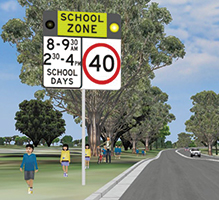
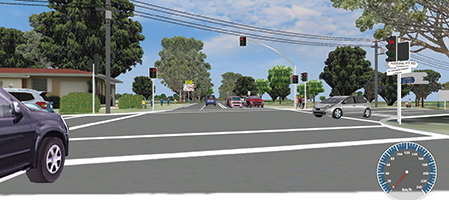
 (Left) In NSW school zone signs with flashing lights remind drivers of
school zone operation
(Left) In NSW school zone signs with flashing lights remind drivers of
school zone operation(Right) VR of drivers stopped in intersection with school zone
In a subsequent study, the phasing of the traffic signals was varied to determine if a shorter stop duration had any impact on drivers forgetting their ‘situation’ in a school zone. Eighty-three undergraduate students participated in a simulated driving test where the interruption was the requirement to stop at a signalised traffic intersection within a school zone.
The prospective memory task was to remember to adhere to the 40 kph school zone speed limit after the interruption. The opportunity to rehearse the intention was provided by the duration of the red light - 15, 30, 60, or 120 s. Interrupted participants were found to drive significantly faster and reported greater forgetfulness for the school zone compared to uninterrupted participants. There were no differences in speed or forgetfulness between the different red light delay conditions. Additionally, scores on the Manchester Driver Behaviour Questionnaire (DBQ; Reason, Manstead, Stradling, Baxter, & Campbell, 1990) were unrelated to participants’ driving simulator speed within school zones, further emphasising the pervasive impact of interruptions on driving outcomes. These findings suggest that speeding is not always intentional and that road infrastructure properties can induce erroneous speeding.
These results were presented by Dr Irwin at the Sixth International Conference on Traffic and Transport Psychology (ICTTP2016) which was held in Brisbane, Australia, in August 2016, under the title Duration of interruption does not affect prospective memory lapse in regard to speeding errors (Authors: Sehr Javed, Julia Irwin and Eugene Chekaluk).
This year, the above studies are being extended to examine other driving situations where motorists may be interrupted by different road design infrastructure such as a roundabout, or signage such as stop signs.
For these researchers, as well as the ability to build a 3D virtual model that replicates the environment and to control intersection design and traffic light phasing, the software’s functionality in logging driver actions through the Log Export plugin and taking a visual record using the Replay function are key features for analysing driver behaviour.
The results of research by Dr. Irwin and her colleagues have been widely reported even in non-academic press (for example in The Conversation - https://theconversation.com/where-drivers-dont-mean-to-speed-its-no-good-just-fining-them-32747), prompting discussion in the Australian community about the deterrent value of fines for speeding, the need for more frequent speed zone reminders both in towns and on the open road, and the role of technologies such as adaptive cruise control and intelligent speed adaption.
Research to assist international driver ‘virtual feedback’
Students of disciplines other than traffic psychology are also using the Forum8 driving simulator. A PhD student in the Department of Computing, Faculty of Science and Engineering, Hasan Alyamani, is conducting a study involving cognitive load when international drivers drive on the ‘other’ side of the road to that with which they are accustomed. His study uses simulated scenarios of both a right-handed and a left-handed traffic system to explore what sorts of driving errors the international driver usually makes and where, when and why they make these errors.
The findings will help to develop a virtual feedback system that decreases the drivers’ cognitive load and improves their driving skills to safely drive under unfamiliar driving conditions. Again, both the safe simulated environment that can be created in Forum8 software and the log file and video record of the drive are essential tools for further analysis of target tasks.
